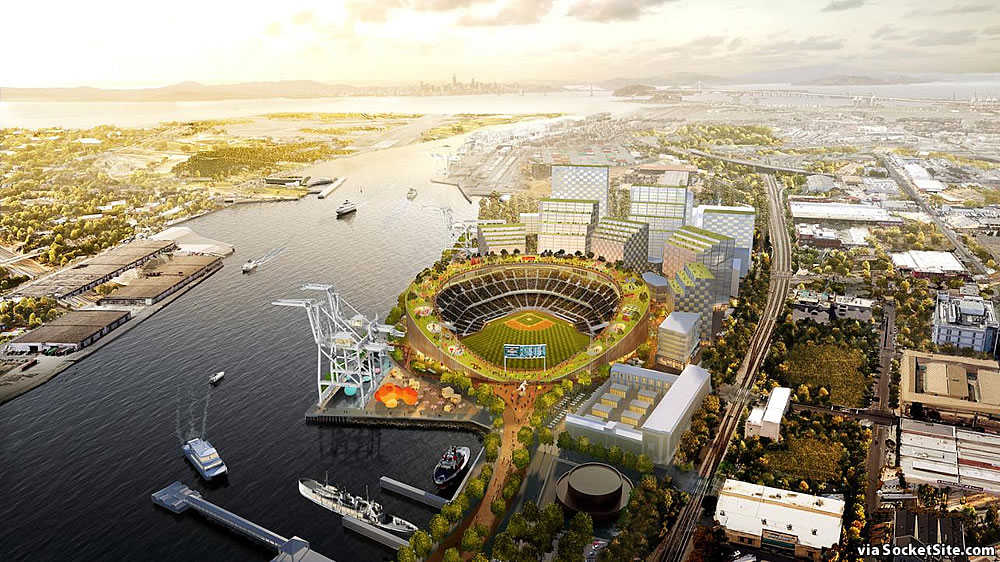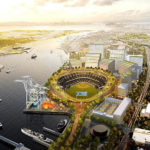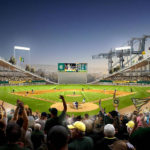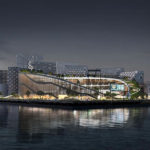The Port of Oakland has granted the Oakland A’s an exclusive, but non-binding, agreement to negotiate the terms of a long-term lease for the 50-acre Howard Terminal site upon which the A’s have drafted, and re-drafted, plans for a new stadium, residential and commercial development to rise.
Under the terms of the exclusive negotiating agreement, which was opposed by maritime interests, the A’s will have four years to secure environmental approvals and permits for the project (including approvals from the Bay Conservation and Development Commission (BCDC), the State Lands Commission and other regulatory agencies), as well as to ink a final term sheet with the Port.
And with that in mind, the A’s stated goal of breaking ground in 2021, and having the new ballpark and gondola connection ready for an opening in 2023, might read as a tad bit aggressive. We’ll keep you posted and plugged-in.





Kudos for the significantly more accurate headline and description than most outlets are running.
The port’s biggest concern is the expansion of the turning basin. In summary, today ships carry about 14K containers. Next big jump is ships that carry 18K containers. Those are about 100 feet longer, the turning basin needs to be widened by at least 100 feet. If you glance at google maps, you’ll see that there are about 4 things in the way:
1) Howard Terminal (currently just a dock with cranes)
2) Schnitzer Steel which operates a dock to load/unload scrap metal into ships.
3) Tug operation that owns a warehouse, dock, tugs and lots of land
4) Shipyard – tows, services ships.
Of those, #1 is most viable source of space since it would shut down as part of this deal. Others are businesses – likely low margin – that require dredged water access and are inherently challenging to relocate, although maybe port of SF might welcome them.
I’m glancing at Google Maps. Couldn’t the northern perimeter of the port, across from the Bay Bridge, be used for those larger ships eventually? The majority of the total port water access seems to be near the labels Oakland Outer Harbor, Key Route Basin, and Oakland Middle Harbor, where there is plenty of room for turning it seems.
Those 18K container ships can stay out of the Oakland Estuary and either use the Oakland Outer Harbor or they can go to Long Beach, Los Angeles or Portland instead.
The Port Authority has no reasonable plan for who would even pay for the expansion to handle those 18K ships and the opposition to expanding the basin will be intense in both Alameda and Oakland. Not to mention, that the opposition to increasing the highway overpass vertical clearance heights for trucks coming to and from the port, something that would be needed if we expand the basin to handle these mega ships, has hit a major roadblock.
In the meantime, the region has an immediate housing crisis, a plan and a need for more frequent ferry service to Jack London, and an intense desire to keep the Oakland As in Oakland. Those are far more important concerns to residents than some far off maritime dream that would require a massive basin expansion in the Oakland Estuary and the highway vertical clearance heights construction needed to accommodate mega ships and mega trucks.
And conversely, there are much better uses of money than likely subsidizing infrastructure and property taxes for professional sports, which is obviously separate from the housing and other development issue.
Contrary to popular belief, there’s no evidence that pro sports ultimately has a positive ROI or economic impact given how much they are both directly and indirectly subsidized.
The A’s have mostly (but not entirely) said the right things to this point in terms of who shoulders what costs, but following through on that and not taking some of the subsidies they are in line for is something that remains to be seen.
The main reason today for giant container ships is that the biggest expense are the crew. A big container ship has the same or maybe slightly larger crew than a small one, so you spend more on the smaller ships.
Ships seem to be relatively easy to be automated (versus cars, trucks, etc.), so it stands to reason that at some point there may not even be any crew due to automation, or maybe just remotely monitored, at least until they need a local pilot to guide them into port. And then you can go slower to save fuel and use smaller ships again.
The fact is that Howard Terminal is only being used as a surface parking lot to store containers and pretty much obsolete for future container ops as the Port along with the operators have invested their dollars at other berths to support the much larger container vessels. Port of Oakland has already deepened its main channel to the outer berths to 55′ years ago to accommodate the bigger vessels, recently placed an order for some of the largest gantry cranes to be seen in North America and like LA & Long Beach will go down the road of automation to handle containers within the port on a much smaller footprint. Ports and the container lines are not looking for space. They are looking for automation and efficiencies to move containers in and out of the gate or onto the vessel as soon as possible as means to minimize and control labor cost.
I still see this as a huge win for the city and Jack London square. Is it a financial windfall? NO. Will Oakland funnel dollars for infrastructure, streets, etc.? YES. Will it keep A’s in the city for decades? YES and who knows, maybe ride a few world series wins just as everyone is excited about the team next door in Oracle.
Finally, A’s current location is prime real estate that should be used for housing, commercial, etc. that would utilize BART 365 days a year vs the 81 home games and provide direct access in the near future to San Fran, Downtown Oakland and San Jose. Go to a game in the Bronx and or Chicago North side and realize that Howard Terminal site is as doable as any other ballpark in the country.
Yankee Stadium and Wrigley are both right next to metro lines… just like the Coliseum site (and unlike HT)
Deep water port facilities have limited possible locations. A baseball park can be sited anywhere. Developing the ballpark at the Howard Terminal precludes its use as a port.
There’s a perfect site for the ballpark already: the Coliseum parcel. It already has excellent rail and road access. If that site is deemed unfavorable because it sits in a sea of parking lots instead of being an urban ballpark like across the bay then bring the city to the Coliseum site. Its transport connections make it a great place to build dense residential and office. And nimby opposition will be weak as the site is already separated from existing residential.
Here is your answer, from The Beauty of America’s Ugliest Ballpark:
Emphasis mine. Go read the whole thing, although it’s silent on any potential uses for the Coliseum site once The A’s have a new home, it’s well worth reading.
The best option is to build next to the existing stadium and then tear the old one down.
Who is going to pay for the Toxic Cleanup, the massive re-routing of truck traffic and rail lines in addition to providing transportation links to and from the stadium. Probably the Tax Payer – that means you. Plus you are destroying a major economic engine that generates 11,000 well paying local jobs, counteless more jobs generated by the economic activity of the port and it’s businesses, plus all the businesses that use the port to ship and recieve their products.
They have the Coliseum that already has parking, BART and freeway access. Build the stadium there and provide the Port of Oakland with the space to meet the next generation of super containerships that can carry 20,000 TEUS (20 foot containers). These monster ships are 1300 feet or more in length, 197 feet wide and draw 52 feet of depth. Protect the port and keep the A;s in the Coliseum.